You're driver #[an error occurred while processing this directive] to make this road-trip since 8/15/99
British Invasion



1969 Lotus Europa S2 (type 54)
Engine: Renault 1470 cc inline-4
Transmission: Renault 4-speed manual transaxle (pushing)
Sold: 2005
| |
|
I bought the Lotus from a local exotic cars dealer in the spring of 1990,
mostly on a whim. The windscreen was cracked, it had some extremely minor
body damage and the paint was trashed, but mechanically it was in good shape.
I practiced my glass-fibre repair skills and tried my hand at spraying paint,
and the result was what you see here. (Incidentally I learned something about
taping and painting drywall, as in the course of painting the car I really
thrashed the interior of the garage at the duplex I was renting at the time, and
felt compelled to rectify the situation.)
Unfortunately I don't drive the Europa often, as it's really not suited to the
Oregon climate: In the summer the large windscreen and small black-finished
passenger compartment combine with poor airflow to create a novel greenhouse
effect; in the winter it leaks due to perished windlace and windscreen gaskets.
I also discovered that Pirelli P-77 tires are definitely not designed for
wet weather (an impromptu "270" in the middle of Burnside Street in downtown
Portland tought me that).
Since I moved into my house in 1996 the Lotus has been stored more-or-less
outdoors and the paint I applied in '90 has weathered pretty badly. Someday
I'll either refurbish it again or sell it, or both.
|
8/9/01 - Time to do some work on the thing...
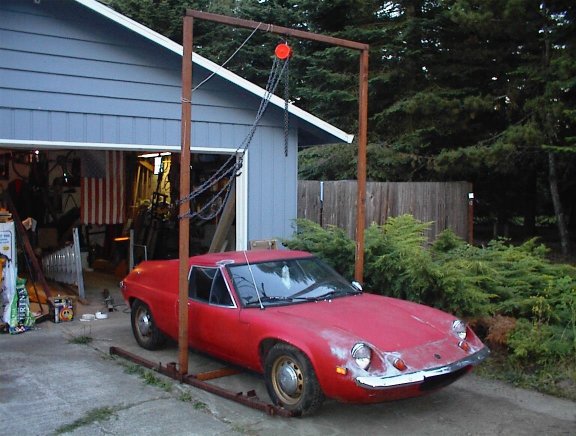
If I'd been thinking, I wouldn't have put the lift frame together
until after I'd disconnected all the doodads -- or at least the
ones inside the passenger compartment: It was quite fun squeezing
through a 10-inch opening -- the widest the doors could open against the
vertical members -- to get to various nuts, bolts, and cables...
.
9/7/01 - Actually gettin' to it
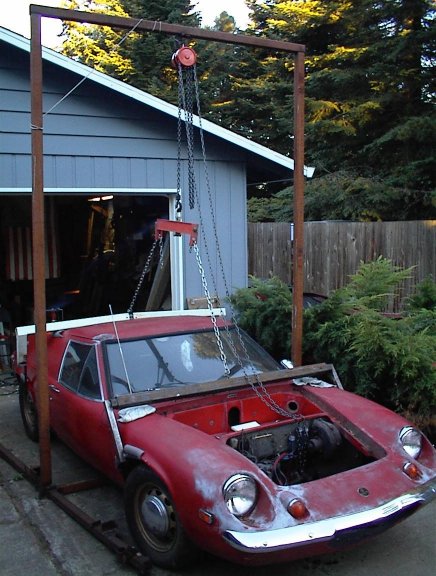
The whole apparat, ready to go for it!
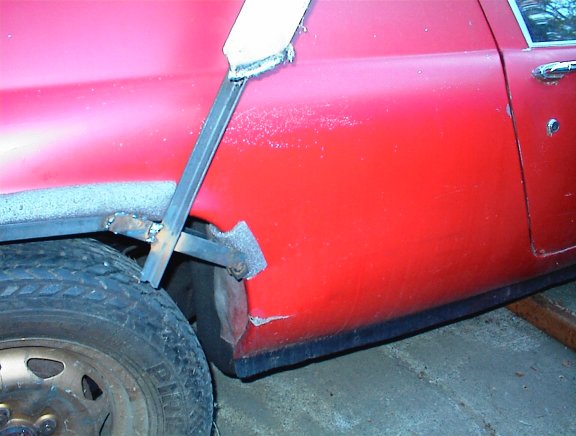
A bit of damage was incurred. (This had less to do with the lifting
rig than the fact that there is a large spot of rotted-out fiberglass
in the bulkhead behind the passenger seat. I'd never noticed that until
I pulled stuff apart this time around.)
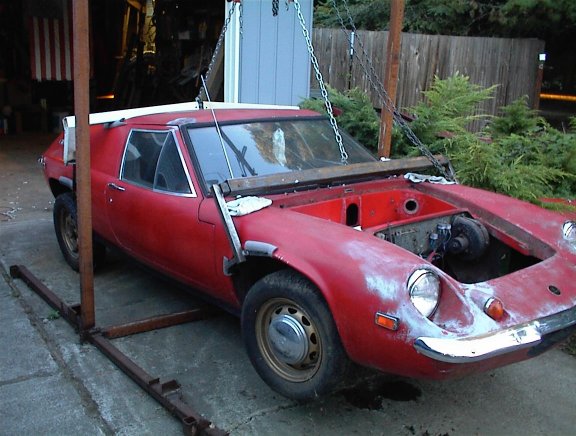
Very worrisome! The rear of the body pulled away from the
frame as expected; the front of the car lifted clear of the ground! I
spent about 90 minutes consulting the service manual and searching for
body-to-frame bolts that I'd missed. Finally I said "screw
it!" and lifted 'er higher then indulged in some pushing and pulling...
turned that it was just a really tight fit after 32 years, and the
backbone eventually slid gracefully out of the body.
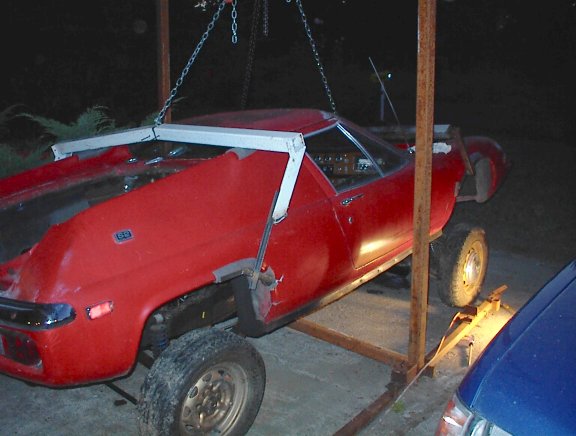
4x4 Monster Lotus!
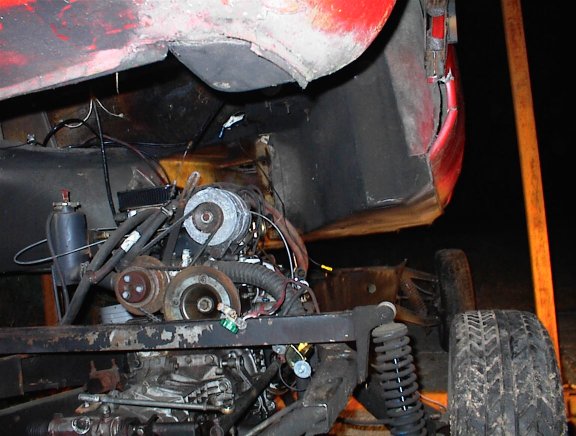
Just a bit higher to clear everything...
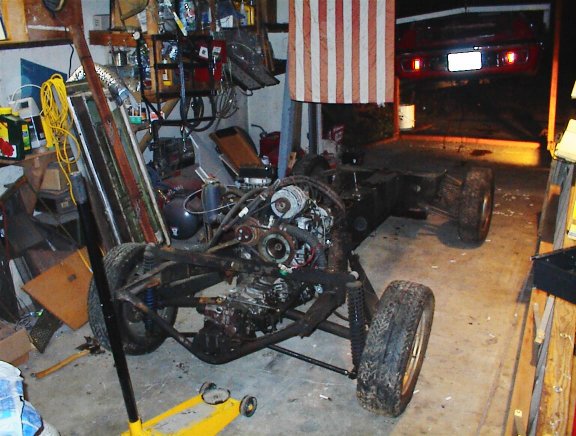
There now, that wasn't so hard... . (Yeah.) Working on the engine,
however, will be a piece of cake!
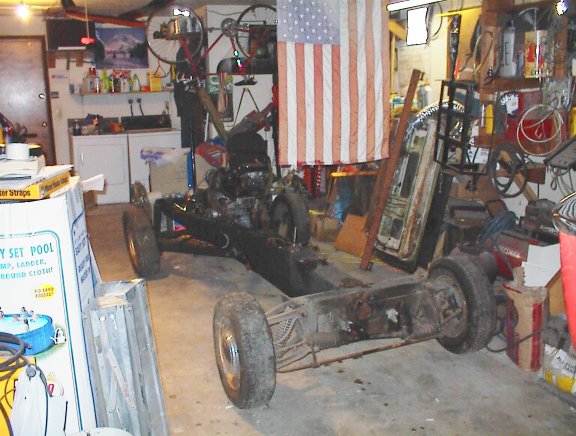
Front view of the frame
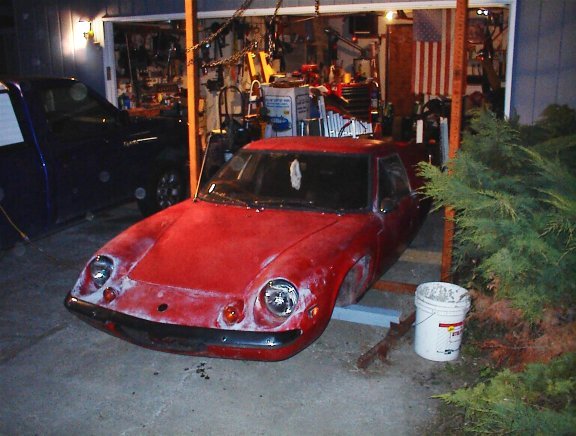
Low-rider Lotus. (The body's sitting on 4-by-4s... and it doesn't look
much lower than usual.)
I should probably disassemble the lift frame tomorrow -- I have the
sense that the neighbors don't like the look of the thing... . (What's
the problem with ten feet of rusty square-tube? I don't get it.)
9/8/01 -- Uh-oh!
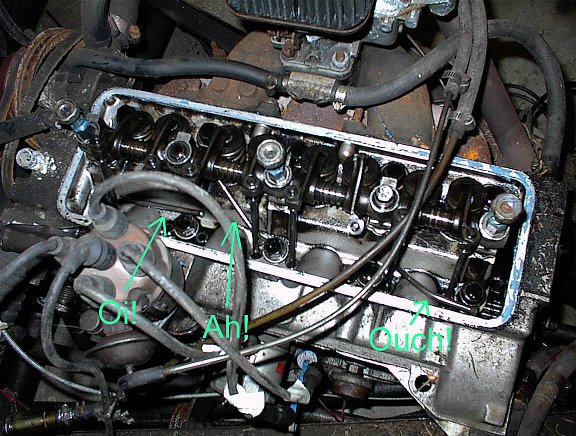
Well. Here's why it stopped running. This is a bit more serious
than varnish in the carburetor jets: Three bent pushrods. Not
good!
At the moment I don't know what happened. It's barely possible that the
clearances got too wide and they just jumped loose, but it's more likely
that the timing chain slipped and the valves slammed some pistons. If I
had any misgivings about pulling the body off, they're gone now -- it
wouldn't be possible to correct this problem with the car assembled.
9/16/01 -- Resto Prep
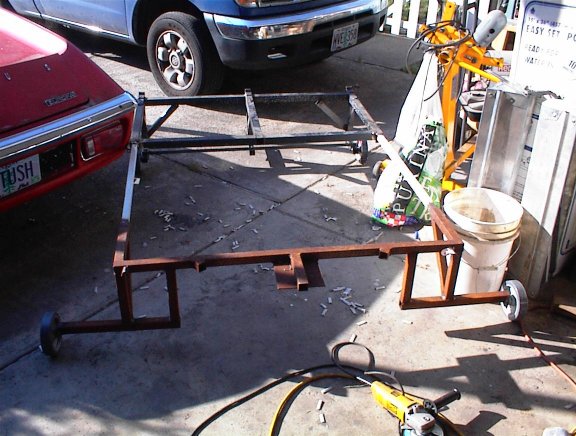
Steerable cart whacked together from old scraps
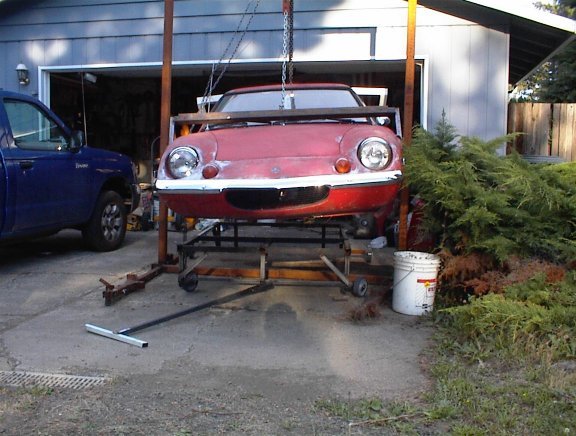
Loading the body onto the cart (after removing the gas tank)
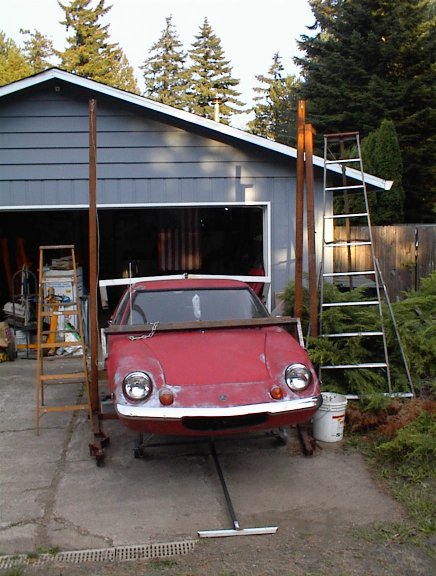
Disassembling the hoist rig
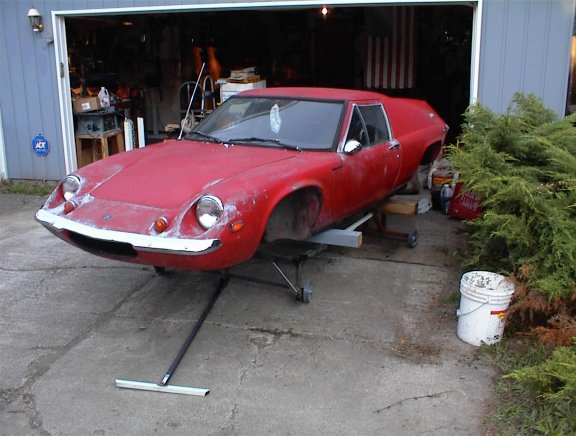
Ready to move the body
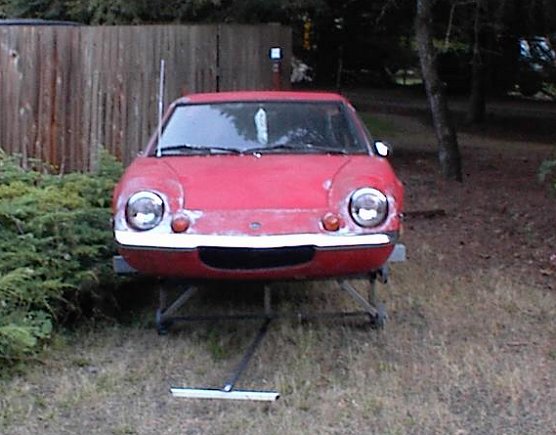
This looks like a good enough spot...
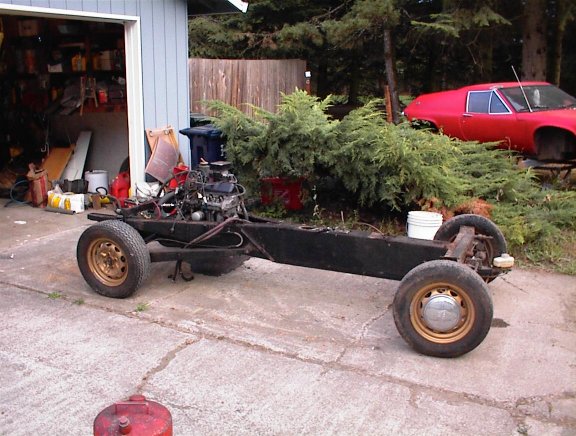
The frame hauled out into the driveway for powerwashing
9/22/01 -- Motor Disassembly
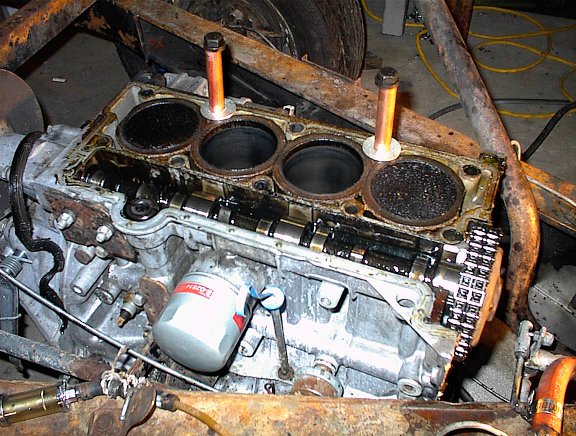
The motor torn down more-or-less to the short block. (The rust on
the frame looks worse here than it really is: I was amazed at just how
good shape it's in.) The copper-tubing arrangements are intended to
keep the cylinder liners in place. The R-16 engine uses wet liners that
are sealed at the top and bottom -- the block itself is essentially a
box full of coolant.
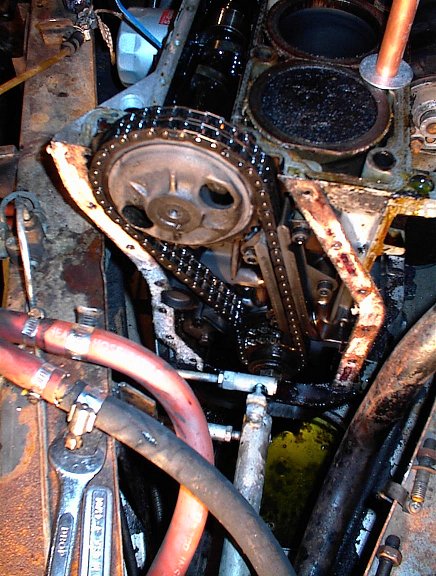
The timing chain looks to be in pretty good shape. Maybe a tension
adjustment is in order, but it doesn't seem to have jumped.
I've checked the valves and tops of the pistons, as well as the cam
lift: I don't think this is an "interference" engine. (i.e. The valves
can't hit the pistons.) Near as I can tell
this is a neglect problem: I haven't adjusted the valve clearances or
retorqued the head bolts in ten years, and it's looking like things got
sloppy enough that the pushrods just worked loose while the engine was
running.
1/10/02
Preparing to reassemble the engine.
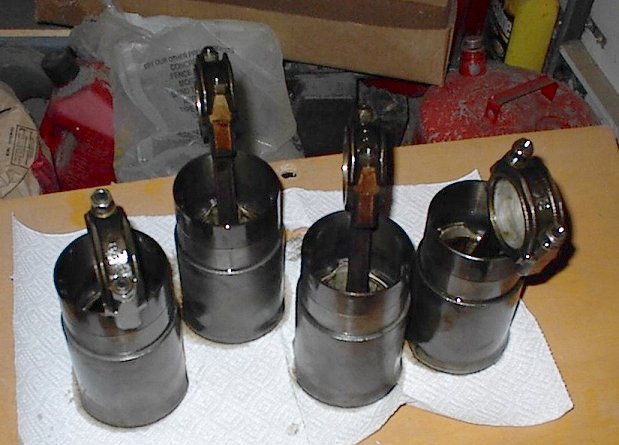
Pistons and liners removed and cleaned up.
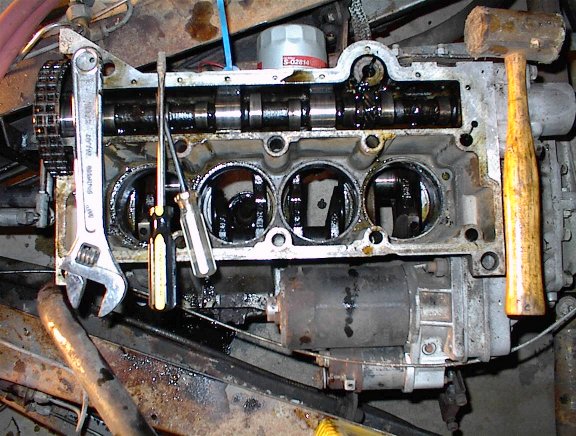
The block with its guts removed.
(PREVIOUS)
(UP)
(NEXT)
[TO MY BIO]
[TO MY HOME PAGE]






















